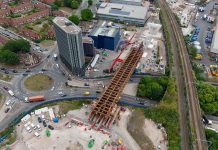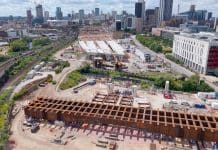HS2 has launched its third giant tunnel boring machine in London, made from repurposed components of Crossrail’s ‘Ellie’ machine
The tunnel will be used to move materials and remove spoil from the northern portal at HS2’s Euston twin bored tunnel rather than for the use of HS2 trains.
The work will be carried out by engineers from HS2’s contractor Skanska Costain STRABAG joint venture (SCS JV), using an 847-tonne machine from the Atlas Road site in North Acton. The engineers will build an 853-metre tunnel to the Old Oak Common Station site.
Work on the tunnel is expected to take around six months and will be constructed using 4,264 concrete segments to form 533 tunnel rings. Each segment weighs over three tonnes and has been produced in Pacadar in Kent. A total of 8,010 tunnel segment rings will be transported in the tunnel. The rings will be transported by rail and the logistic tunnel only as part of HS2’s commitment to sustainable construction.
HS2 also opened a new on-site rebar steel component facility to reduce materials shortages at the Copthall tunnel in Hillingdon recently as part of their HS2 Net Zero Carbon target. The rebar facility will include 92,000 rebar steel couplers and will be constructed by a team of 14 engineers. According to HS2, the facility will cut waste and emissions from lorry movements and create new jobs.
“We are always looking at ways to improve construction efficiency and are pleased to support our construction partners in developing solutions like this and getting them off the ground,” said HS2’s project client, Malcolm Codling.
Materials from HS2 will be recycled elsewhere
A conveyor system will also run through the logistics tunnel to excavate clay from London to HS2 London Logistics Hub at Willesden Euro Terminal. Spoil will then be transported taken for reuse and sites in Kent, Rugby, and Cambridgeshire.
The conveyor network has three spurs, serving the Old Oak Common station site, the Atlas Road site, and Victoria Road Crossover box site. HS2 Ltd.’s station contractor, BBVS JV, uses the conveyor system to remove spoil and excavate it to the station box, the subsurface structure in which the HS2 platforms will be constructed.
“The Atlas Road Logistics Tunnel is key to how we will be constructing the Euston Tunnel between Old Oak Common and HS2’s Euston station. The logistics tunnel allows us to take 70,000 lorry journeys off the local roads that would otherwise have been required and will reduce the impact of HS2’s construction on the local community,” said Malcolm Codling, HS2’s project client for the London Tunnels.
The tunnel boring machine has also been recycled
The tunnel boring machine being used on the project has been repurposed using components from an existing tunnel boring machine used on the Crossrail project. The tunnel boring machine, called ‘Ellie’, was used to dig two sections of the Crossrail tunnels in London from Limmo Peninsula in Canning Town to Royal Victoria Dock and between Pudding Mill Lane and Stepney Green.
Herrenknecht, a specialist tunnel boring machine manufacturer, has designed the tunnel boring machine specifically for HS2’s requirements with a cutting wheel and shield. The tunnel boring machine has been named ‘Lydia’ in keeping the tradition of naming tunnel boring machines after women. The tunnel boring machine was named after Lydia Gandaa, a former teacher at Old Oak Common Primary School and a founding member of the Bubble & Squeak social enterprise in the area.
“This is our third tunnel boring machine to launch in London, and later this year, we will have five machines operating. Four of these will be boring the HS2 tunnels linking West Ruislip and Old Common. Today’s launch is significant as it is not used for the operational railways but will create a direct link between our logistics hub and Old Oak Common, allowing us to transport tunnel segments and spoil without using local roads,” said James Richardson, managing director of Skanska Costain STRABAG JV.



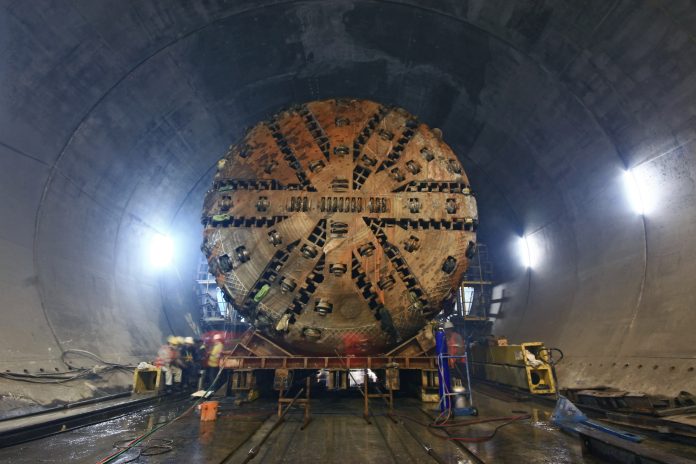
![[VIDEO] HS2 completes 4,600-tonne viaduct slide across M6 The HS2 team completed a 17-hour long operation sliding the viaduct structure across the M6 without closing the motorway](https://www.pbctoday.co.uk/news/wp-content/uploads/2025/12/M6-South-viaduct-slide-taking-place-across-a-live-motorway-December-2025-218x150.jpg)


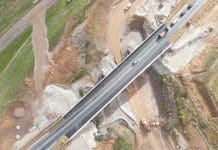
![[VIDEO] HS2 celebrates final boring tunnel breakthrough The 125-metre-long tunnel boring machine was launched in March 2024 and arrived at Washwood Heath yesterday morning (13 October)](https://www.pbctoday.co.uk/news/wp-content/uploads/2025/10/HS2-staff-engineers-and-tunnellers-gather-in-front-of-the-Bromford-tunnels-after-the-breakthrough-of-Elizabeth-Oct-2025-218x150.jpg)

![[VIDEO] HS2 M6 viaduct slide completed early The HS2 M6 Viaduct on its sliding journey](https://www.pbctoday.co.uk/news/wp-content/uploads/2025/09/M6-viaduct-East-Deck-in-place-over-the-motorway-September-2025-218x150.jpg)
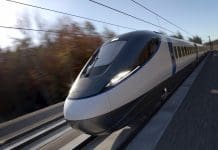
![[VIDEO] UK’s longest rail bridge completed The UK's longest rail bridge has been completed for HS2](https://www.pbctoday.co.uk/news/wp-content/uploads/2025/09/250801_ColneValleyViaduct_Drone-still_004-218x150.jpg)
